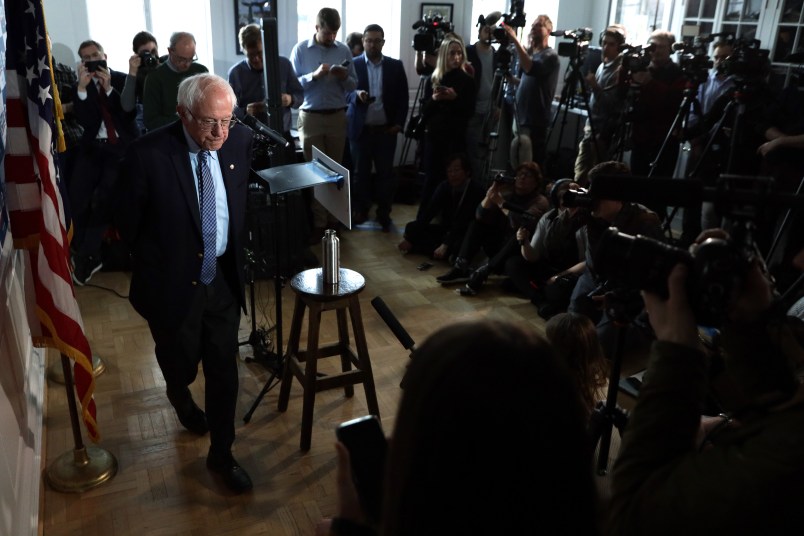Sen. Bernie Sanders (I-VT) cancelled a rally in Jackson, Mississippi scheduled for Friday, opting to try and shore up Michigan instead.
He was likely reacting to the strong headwinds steering the race since former Vice President Joe Biden came roaring back to the front of the pack with decisive wins in South Carolina and on Super Tuesday.
But in Michigan, there were signs Sanders was competitive, or better. Polling in the state has been sparse, but a YouGov poll from mid-February found the democratic socialist 9 points ahead.
Since then, trends have mirrored those nationwide, and reversed.
Michigan State Associate Professor of Political Science Matt Grossmann estimates that Biden is “slightly ahead and growing in the wake of Super Tuesday.”
A Detroit News/WDIV-TV poll published Tuesday shows Biden at 29 percent to Sanders’ 22.5, though that poll was put in the field before former New York City Mayor Mike Bloomberg and Sen. Elizabeth Warren (D-MA) dropped out.
That poll is part of Biden’s upswing in the state, which has been apparent since right after Super Tuesday. Before that, the former Vice President had been steadily cratering until Sanders finally surpassed him in mid-February. As of Sunday evening, Biden held seven-point lead in FiveThirtyEight’s polling average: 37.8 percent to 30.1.
But the newly free supporters of candidates who dropped out one after another, and very quickly, will factor in to Tuesday’s outcome as well. Pollster Richard Czuba of the Glengariff Group, based in Lansing, told TPM that based on recent polling by his firm, he expects Sanders will get 42 percent of Warren’s support, and 25 percent will go to Biden.
While Warren’s supporters could mean a Sanders bump, he noted, Biden will also be cleaning up with Bloomberg’s supporters. That’s significant because Warren was only pulling about 7 percent of respondents; Bloomberg had over ten percent.
For Grossmann, the redistribution of voters will ultimately be determined by how Warren’s supporters choose to vote: in line with their ideologies, or their demographics.
“The basic dynamic is that Warren’s coalition is very liberal — even more liberal than Sanders’. I expect if people are voting along that dimension, they may go Sanders,” he said.
“But her demographic coalition is exactly the same one that is moving Biden: more white suburbanites, more women, more educated voters.”
Sanders isn’t leaving it all up to chance. Since Biden started picking up a head of steam, Sanders has been running ads in the state to target the former Vice President on social security and free trade agreements. But it may not have much of an impact, said political consultant Mark Grebner, who runs his firm out of Lansing.
“1.3 million, 1.4 million people will vote in this Democratic primary and a million of those are the most usual suspects you’ve ever seen in your life: 50, 60, 70 year old, well-established Democratic voters,” he said.
A recent poll from the Glengariff Group shows that Biden fares particularly well with older Democrats, a trend in Super Tuesday states as well. While Sanders’ favorables dip with older groups, 53.3 percent of respondents in the 50 to 64 category have a favorable impression of the senator, while 52 percent of those 65 and older do.
Those numbers pale, though, in comparison to Biden’s favorability with those groups: 68.1 percent and 84.3 percent, respectively.
In order to win now, Grebner told TPM, Sanders will have to cobble together factions in numbers that just aren’t there.
“He’d have to add several hundred union workers, stop getting killed with people above 60, turn out more college kids and scrape together 650,000 votes? Good luck,” Grebner said. “I wouldn’t bet on it.”
However, Sanders has upset expectations before. In 2016, polls projected Hillary Clinton winning by double digit margins, until Sanders ultimately won the state by 1.5 points. FiveThirtyEight’s Editor in Chief Nate Silver called it “among the greatest polling errors in primary history.”
But some of the factors that helped Sanders bamboozle the world of statisticians may not fall so neatly into his column this time around.
Grossmann identified two key points: there is no contested Republican primary, and Sanders has lost ground with rural white voters.
In 2016, the Republican primary was seen as the last chance to stop President Donald Trump. The Democratic nomination, meanwhile was considered a foregone conclusion. So, Grossman contended, some Clinton voters crossed over to vote in a race that seemed more contentious, allowing Sanders to take the lead.
This year, there is only one one race that counts.
Grossmann also noted that in 2020, Sanders has seemed to lose ground with rural, less educated voters and to gain Latinos. While “that was okay on Super Tuesday in California and Texas,” it’s a “horrible trade in Michigan.”
“We’re only 3 percent Latino,” Grossmann said. “We have a large white working class.”
And finally, in a race that’s been all about momentum, there may simply not be enough time for Sanders to expand his base before election day on March 10. Early voting started back on January 25, but Michigan allows voters to “spoil” their ballots. Per the Detroit News, Biden is leading Sanders in absentee ballots already cast.



